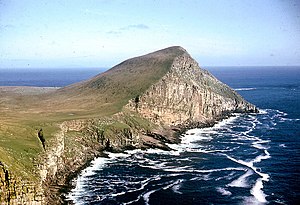Foula
| Foula | |
|---|---|
| The Noup on Foula | |
| Waters | Atlantic Ocean |
| Archipelago | Shetland Islands |
| Geographical location | 60 ° 8 ′ 20 ″ N , 2 ° 4 ′ 19 ″ W |
| length | 5.6 km |
| width | 4 km |
| surface | 12.65 km² |
| Highest elevation | The Sneug 418 m |
| Residents | 38 (2011) 3 inhabitants / km² |
| main place | Ham |
| Ordnance Survey Map (1961) | |
Foula is a remote island in the Scottish Shetlands ; the Vikings called it Fugley ("bird island").
The bare, westernmost Shetland Island has belonged to the Holbourn family since the turn of the 20th century.
The 12.65 km² island is permanently inhabited and, according to the 2011 census, had a population of 38 people. With the nearest settlement 35 km away, Foula is considered the most remote of all the inhabited British Isles . The film Edge of the World (1937) by Michael Powell used Foula as a location.
The island is known for its cliffs on the west side, which are up to 370 meters high, and the variety of its birds, including the arctic tern and the red-throated diver.
Simon Martin, who spent five years on Foula, describes the island as follows: “Foula, or Ultima Thule as it was known during Roman times, extends out of the water, and the five peaks Noup, Hamnafield, Sneug, Kame and Soberlie stand up stiffly and characteristically. The cliffs, along with those of St. Kilda, are considered to be the highest in Great Britain. They tower around 400 meters above sea level. "
The surface of the island consists largely of a peat bog over the rock. The island has a large number of prehistoric and protohistoric structures that are more general in nature but also reflect the typical situation of the windswept island. They are assigned with Old Norse terms:
Archaeological finds
In 2007, a team of archaeologists from Bath discovered an ancient stone circle called “Da Heights” in this most remote place in Great Britain. Its structure is similar to that of other circles from the late Neolithic or early Bronze Age . The date of the ring, which was hidden under a 60 cm layer of peat, is still unclear. The team took peat samples for further analysis in the hopes that the pollen would provide clues as to the date. The orientation of the stone ring to the winter solstice is of great importance as there is only a few hours of daylight in winter. Knowing that the days are getting longer and warmer was therefore very important. The county on Foula is the northernmost in Scotland , along with Hjaltadans on Fetlar .
The menhir "The Brethren" stands nearby .
- Boat noost ; Boat-shaped sunbathing holes as wind protection for boats (Ham Ayre, Da Doon, Da Riggs, Strem Ness)
- Burnt mounds ; ancient ash mounds (Harrier, Wurly Knowe)
- Cairns ; Stone graves (Da Sneug, Da Auld Skeos, Lamus o da Wilse, North Harrier, South Ness - several)
- Cookie Dykes and Croft Dykes; Pasture boundaries made of earthen walls, stone walls or fences on steep places or around pastureland (bloburn)
- prehistoric levees and terraces;
- old house foundations; (North Harrier Yard and Chapel)
- Horizontal watermills (Bankwell, Stoel)
- Kail yards; walled, wind-protected fields (Biggins Hill)
- Maid Cairns; Piles of stones piled up as navigation marks
- Mooldikus (Mouldie Kus); stone-walled peat heaps set up to dry (Soberlie)
- Mounds; artificial hills
- Planticrubs; Wind-protected stone-walled fields (Bankwell, Stoel)
- Sheep cruise; Sheep coralls and gripsters funnel-shaped guide walls to round up the animals
- Snaa Buils; Snow houses as a refuge for sheep
- Skeos: fish drying houses (Quinister, Sloag)
- Stane Brigs: Stone Bridges
- Stone boxes (English Cist) (Da Brederin)
Foula is of interest to linguists who discovered new vocabulary of the old norn here . The theologian George Low, who visited Shetland in 1774, compared the dialects of Foula and Orkney and collected material on the island's linguistic history. His ballad of the Orkney Earl and the Norwegian Princess is the longest poem in the old norn at 35 verses. However , it has been extinct since 1928, when it was still spoken in Foula and Unst . To this day, Scottish English, especially the dialects of the Shetlands and Orkney, has been heavily influenced by the Norn. Like Icelandic and Faroese, Norn was a West Scandinavian language (island Scandinavian). The Faroese comes closest to the norn.
Time calculation
Foula kept the Julian calendar even after the United Kingdom adopted the Gregorian calendar in 1752. The year 1800 appeared as a leap year, whereas the year 1900 was not taken into account as a leap year. As a result, Foula is one day ahead of the Julian calendar and twelve days behind the Gregorian calendar. Christmas Day falls on January 6th (Gregorian), New Year on January 13th (Gregorian). If you want to visit or leave the island on the days in question, do two things: The holidays are celebrated twice - in Shetland respected - and ferry and air traffic are accordingly idle.
Infrastructure
The island still has no electricity. Three times a week runs the ferry from Walls and Scalloway , and several times a week flying Loganair from Tingwall from the airport Foula on.
Individual evidence
literature
- David E. Pedgley: Foula's flans - in the wake of a hilly island. In: Weather. Vol. 56, No. 4, 2001, ISSN 0043-1656 , pp. 118-125, doi : 10.1002 / j.1477-8696.2001.tb06548.x .
Web links
- Prehistoric monuments ( Memento from March 22, 2007 in the Internet Archive )




